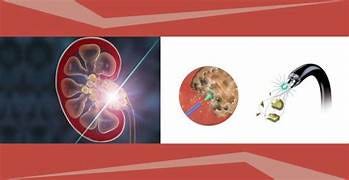Laser kidney stone treatment, also known as laser lithotripsy, is a minimally invasive medical procedure that effectively treats kidney stones. Kidney stones, or renal calculi, are hard deposits made of minerals and salts that form inside the kidneys. They can cause severe pain, urinary discomfort, and potential complications if left untreated. Laser lithotripsy is one of the most effective and preferred methods to break down kidney stones and remove them from the body, offering a shorter recovery time and minimal risks compared to traditional surgical options.

How Laser Lithotripsy Works
Laser lithotripsy is performed under anesthesia, typically on an outpatient basis. The procedure begins by inserting a small, flexible ureteroscope, a thin tube with a camera, into the urethra and through the urinary tract to locate the kidney stones. Once the stones are located, a laser fiber is introduced through the ureteroscope, and high-intensity laser energy is directed at the stones. This energy breaks down the kidney stones into tiny fragments, which can then either be naturally passed out through the urine or removed with the help of specialized instruments.
Types of Lasers Used
The Holmium YAG laser is the most commonly used laser in lithotripsy due to its precision, effectiveness, and safety profile. This laser is highly versatile and can fragment stones of various sizes and compositions. The energy from the Holmium YAG laser is absorbed by water in the tissues, which minimizes any potential damage to surrounding tissues and structures in the urinary tract. Other types of lasers, such as Thulium fiber lasers, are also gaining popularity for their efficiency and ability to fragment stones into even finer particles, allowing for easier and faster passage.
Benefits of Laser Lithotripsy
Laser lithotripsy offers multiple advantages:
- Minimally Invasive: Laser lithotripsy does not require any incisions. The ureteroscope and laser fibers are inserted through the urethra, which results in minimal tissue trauma and a reduced risk of infection.
- High Success Rate: Laser lithotripsy can fragment stones of varying sizes and types, including larger or complex stones, which may be difficult to treat with other methods.
- Reduced Recovery Time: As it is minimally invasive, patients usually experience a quicker recovery time and can resume normal activities sooner than with open surgery.
- Outpatient Procedure: Most patients can return home the same day, reducing the need for a prolonged hospital stay and associated costs.
- Precise Stone Targeting: The laser’s precision allows it to target stones without damaging surrounding tissues, minimizing potential complications.
Risks and Considerations
Although laser lithotripsy is generally safe, it may involve some potential risks and side effects, including:
- Infection: As with any procedure, there’s a slight risk of urinary tract infections.
- Bleeding: Minor bleeding may occur, especially in the urinary tract.
- Stone Fragments: Some patients may experience discomfort as fragmented stones pass through the urinary tract. Medication can be prescribed to manage pain, and drinking plenty of fluids helps in flushing out the fragments.
- Ureteral Injury: There’s a small risk of injury to the ureter, but this is rare due to the minimally invasive nature of the procedure and the precision of laser technology.
Post-Procedure Care
After laser lithotripsy, patients are advised to stay hydrated to aid in flushing out any remaining stone fragments. They may experience mild discomfort, such as burning sensations during urination or traces of blood in the urine, which typically resolve in a few days. Medications may be prescribed to manage pain and prevent infection. Follow-up appointments are essential to monitor the healing process and ensure complete stone clearance.
Conclusion
Laser kidney stone treatment has transformed the management of kidney stones, offering a safe, efficient, and minimally invasive alternative to traditional surgery. Its high success rate, precision, and reduced recovery time make it an appealing choice for patients seeking relief from kidney stone discomfort.





.jpeg)
Comments